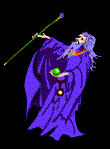
The Return of Dungeons & Dragons
In 1997, Wizards of the Coast bought TSR and relocated the operation to Washington. Publication of AD&D materials, which had been suspended for half a year due to distribution and financial problems, resumed, and Wizards started the process of resuscitating AD&D and the AD&D computer licence. D&D had for a time disappeared from the CRPG scene. Interplay had first taken a licence to make a D&D game in late 1994 just before SSI gave up their licence. Acclaim also made an abortive attempt at a game with a D&D licence. Interplay seemed to be using the licence like SSI had done to make poor games to be sold purely on the D&D connection and their first games - Blood and Magic (1996) and Descent to Undermountain (1998) did nothing to dispel this view.
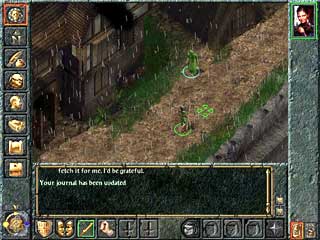 The
release of Baldur's Gate in 1998, proved that good games could have
a D&D licence. Baldur's Gate was not a very original game in terms of
setting or main gameplay ideas, it was a pretty good reproduction of the TSR's
Forgotten Realms World and the AD&D 2nd edition rules on a computer. (There
were a few rule inconsistencies as the game could not balance every possible
character class combination or implement every rule. What
made the game groundbreaking was that it showed in detail every area of the
Sword Coast in considerable graphic beauty with a strong accompanying sound
track and to do this it came on five CDs. These regions have a day and night
and different events and encounters can happen at different times of day.
The
release of Baldur's Gate in 1998, proved that good games could have
a D&D licence. Baldur's Gate was not a very original game in terms of
setting or main gameplay ideas, it was a pretty good reproduction of the TSR's
Forgotten Realms World and the AD&D 2nd edition rules on a computer. (There
were a few rule inconsistencies as the game could not balance every possible
character class combination or implement every rule. What
made the game groundbreaking was that it showed in detail every area of the
Sword Coast in considerable graphic beauty with a strong accompanying sound
track and to do this it came on five CDs. These regions have a day and night
and different events and encounters can happen at different times of day.
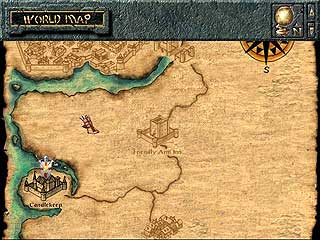 There
is an overview map of the Sword Coast showing the towns, mines and forests,
etc. Each area can be explored in an isometric rendering using the Infinity
engine of this chunk of the map. Characters and monsters are placed believably
on the map and interact with the player to further the story or as interesting
subquests. However, the player could go anywhere on the map. The clever trick
of the designers was to direct the player to areas he could cope with at his
current level of ability, this was partly done by allowing the player only
to go to the area adjacent to the map side he is on or to areas he has already
visited. The player may know he has to find a certain character to advance
the plot but may have no idea where that character is, so exploration and
searching for rumours and clues and deciding what is true and what is not
is a big part of the game. The player may be off on some sub quest in an area,
which is not necessary to go to actually finish the game, but the plot will
always bring the player back to the story of the game. The problem of all
this detail is of course that it cannot be as free form as Fallout but the
player still has many choices to make.
There
is an overview map of the Sword Coast showing the towns, mines and forests,
etc. Each area can be explored in an isometric rendering using the Infinity
engine of this chunk of the map. Characters and monsters are placed believably
on the map and interact with the player to further the story or as interesting
subquests. However, the player could go anywhere on the map. The clever trick
of the designers was to direct the player to areas he could cope with at his
current level of ability, this was partly done by allowing the player only
to go to the area adjacent to the map side he is on or to areas he has already
visited. The player may know he has to find a certain character to advance
the plot but may have no idea where that character is, so exploration and
searching for rumours and clues and deciding what is true and what is not
is a big part of the game. The player may be off on some sub quest in an area,
which is not necessary to go to actually finish the game, but the plot will
always bring the player back to the story of the game. The problem of all
this detail is of course that it cannot be as free form as Fallout but the
player still has many choices to make.
The story works like that of Betrayal at Krondor, it is in chapters with a specific objective to be achieved that will then reveal a bit more of the story and open a new chapter and objective. The player's character has mystery surrounding him, starts as a young nobody, forced to leave his home with assassins trying to kill him, and as the story develops he becomes one of the most powerful figures in the land. The player meets NPCs that will join his party and may have their own agendas or quests that want performing. These and alliance differences could result in conflict with the player or other members of the party leading to disagreements or a party break-up. The NPCs are balanced with advantages and disadvantages, for instance the mighty ranger Minsc has a miniaturized giant space hamster - Boo who is simply there to take up an item slot.
The combat system used the Bioware Infinity Engine and is a mixture of real time and turn-based systems. Characters are set in an auto mode and will follow a script to attack, use a bow or cast spells resolved according to a continuous quick-paced turn based system that gave a sense of real urgency to the player. However, the player could pause the game to issue his orders rather than do it as the action progressed, but some players found this annoying. Another problem with this system was that the script engine never fully worked even after patching.
The system is original in that it is not a click the mouse like mad Diablo style action system or slow-motion combat like in console RPGs. The system allowed some elements of strategy. The player could use a mix of fighters with melee weapons in the front ranks and other classes using magic or missiles in the rear. A thief could for instance hide-in the shadows and then be sent down a corridor to look for enemies and traps and even backstab an enemy and drawing the rest into an ambush from the rest of the party.
The game allowed game saves at any point except in combat or very close to enemies but had a limited number of save boxes and would respawn monsters if the player saved in a hostile dungeon area.
The game had bugs including random lock-ups, which the patches never sorted out. There was some poor AI path-finding code, characters could block each other in tight corners and some of the scenes and areas are too small to fight in.
 Baldur's
Gate II: Shadows of Amn (2000) continued the story stated in the first
game. It had a number of technological improvements with the graphics went
up to a 800x600 pixels display, the game supported 3D accelerators for improved
lighting effects. The pathfinding routine was much better, but still far from
perfect. The game introduced some new character classes and sub classes and
abilities. Parties get to start out at a higher level, with more abilities
to play with. The story was still engrossing, with a much bigger game world
to explore. The player could actually successfully play an evil character
and party. The system now used travel over a map of the country in the Darklands
style rather than moving from terrain tile to terrain tile. The dungeons were
bigger and graphically better than in the first game.
Baldur's
Gate II: Shadows of Amn (2000) continued the story stated in the first
game. It had a number of technological improvements with the graphics went
up to a 800x600 pixels display, the game supported 3D accelerators for improved
lighting effects. The pathfinding routine was much better, but still far from
perfect. The game introduced some new character classes and sub classes and
abilities. Parties get to start out at a higher level, with more abilities
to play with. The story was still engrossing, with a much bigger game world
to explore. The player could actually successfully play an evil character
and party. The system now used travel over a map of the country in the Darklands
style rather than moving from terrain tile to terrain tile. The dungeons were
bigger and graphically better than in the first game.
The big improvement was with the NPCs they ask questions, give opinions, talk amongst each other and the player can have romantic entanglements with them. NPCs can also be linked to the main plot and one can even betray the player. Each NPCs is linked to his own sub quests so the player must make the decision should he stay with his current party members and continue to develop them in power or pick a new weaker member to do that subquest. The decision is even more marked in multiplayer games as the player made characters are more powerful but block out party of the games story. There are 16 NPCs but the player can only have a maximum of 5 in the party at any one time. The Baldur's Gate series including the add on games sold almost five million units world-wide.
For the PS 2 Baldur's Gate: Dark Alliance (2001) and Baldur's Gate: Dark Alliance II (2004) for X-BOX and PS2 were action CRPGs without the story or character interaction of the PC games.
 Planescape:
Torment (1999) is considered by many game critics to have the best written
story line in a CRPG. However, the game did not achieve the same commercial
success of Baldur's Gate, despite favourable reviews, a number of accolades
such as 1999 RPG of the year and the efforts of Interplay's marketing machine.
The reason was put down to the more mature storyline and sheer amount of text
the player had to read and that wordy-story driven CRPGs are not that commercial.
The D&D setting was a minor one compared to that of Baldur's Gate. The
games initial release was seriously buggy and the well-known interface from
Baldur's Gate was changed to keyboard shortcuts and, keyboard + mouse combinations,
which were more difficult to use. This was necessary to make room for the
larger and more detailed animations.
Planescape:
Torment (1999) is considered by many game critics to have the best written
story line in a CRPG. However, the game did not achieve the same commercial
success of Baldur's Gate, despite favourable reviews, a number of accolades
such as 1999 RPG of the year and the efforts of Interplay's marketing machine.
The reason was put down to the more mature storyline and sheer amount of text
the player had to read and that wordy-story driven CRPGs are not that commercial.
The D&D setting was a minor one compared to that of Baldur's Gate. The
games initial release was seriously buggy and the well-known interface from
Baldur's Gate was changed to keyboard shortcuts and, keyboard + mouse combinations,
which were more difficult to use. This was necessary to make room for the
larger and more detailed animations.
The player character is the Nameless One who wakes up in a mortuary with amnesia. The player slowly discovers that the character is now immortal and as the player journeys through the Planetscape planes of existence he learns about the characters past life and must come to terms with horrible deeds committed in the past.
Torment has multiple endings, which are dependent on the player's alignment, which is determined by the player's behaviour in the game. The player can be evil or a do-gooder. Although not as freeform as Morrowind, it does give the player a large multiverse to explore. Battles are real-time tactical ones similar to Baulder's Gate.
The character class system allows flexible customisation of not only the main character but also the party of unique and grotesque characters is almost as customisable as the hero himself. The player can recruit a talkative flying skull as a companion, and then equip him with different kinds of teeth as weapon upgrades.
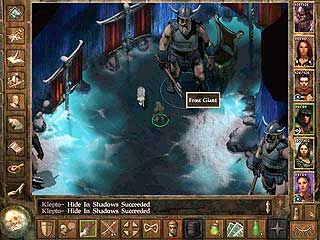 Icewind
Dale (2000) was an action CRPG set in the northern most region of AD&D
Forgotten Realms with the same Infinity engine as Baldur's Gate licenced from
Bioware by Interplays Black Isle development studio. It was a commercial success
and players appreciated the strategy and control the system give them compared
to Diablo. (The AI and scripting problems were still evident.) Although the
game has a good story with some twists the game is completely linear, the
player gets a major quest, goes into a dungeon, kills everything, comes back
and then receives the next quest. The player has no choices to make about
his character. The game was followed up with an expasion pack - Icewind
Dale: Heart of Winter (2001) and a sequel - Icewind Dale II (2002).
Icewind
Dale (2000) was an action CRPG set in the northern most region of AD&D
Forgotten Realms with the same Infinity engine as Baldur's Gate licenced from
Bioware by Interplays Black Isle development studio. It was a commercial success
and players appreciated the strategy and control the system give them compared
to Diablo. (The AI and scripting problems were still evident.) Although the
game has a good story with some twists the game is completely linear, the
player gets a major quest, goes into a dungeon, kills everything, comes back
and then receives the next quest. The player has no choices to make about
his character. The game was followed up with an expasion pack - Icewind
Dale: Heart of Winter (2001) and a sequel - Icewind Dale II (2002).
In 1999, it was announced that Mindscape, the parent company of SSI and now a division of Mattel, had reclaimed the licence, and that Stormfront Studios the original developers of Pool of Radiance had been working on a sequel for more than a year. Pool of Radiance: Ruins of Myth Drannor (2001) was finally published by Ubi Soft Entertainment, it was the first game to use the new 3rd Edition D&D rules but was buggy, gameplay was poor and was more of an Action CRPG, and it rapidly made its way to the bargain bins.
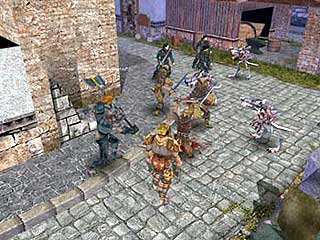 Neverwinter
Nights (2002) developed by BioWare was based on the Dungeons and Dragon
3rd edition rules. The big change was the Aurora engine which produces a 3D
graphical world. The player can view the Forgotten Realms word from many angles,
the graphical effects from magic spells and looking at reflections in water
and metal armour are very well done. However, the engine requires a powerful
PC and 3D accelerator card to get the best results and many players say they
preferred the hand drawn artwork of the older Infinity engine anyway.
Neverwinter
Nights (2002) developed by BioWare was based on the Dungeons and Dragon
3rd edition rules. The big change was the Aurora engine which produces a 3D
graphical world. The player can view the Forgotten Realms word from many angles,
the graphical effects from magic spells and looking at reflections in water
and metal armour are very well done. However, the engine requires a powerful
PC and 3D accelerator card to get the best results and many players say they
preferred the hand drawn artwork of the older Infinity engine anyway.
The character class systems although slightly different is no big change, although again some die hard fans say they prefer the old edition of the rules. Combat is a combination of an action adventure game in that the player has to hit the monster by controlling his character, together with the calculated stats of a paper and pencil RPG.
The game plot, dialogue and gameplay of advancing the story are nothing special and perhaps are not as well done as earlier games such as Baldur's Gate 2, some players have even described it as boring. Multiplayer modes include Dungeon Master, where one player controls the traps and battles set for other players in the dungeon and a range of other game types such as hunting for treasure or a simple death match battle between players.
What has inspired players was the inclusion of the Neverwinter Aurora Toolset that allows a player to create his own fantasy world. This took the moding world by storm and with some knowledge of C++ or ability to create 3D art, moders could put together a whole dungeon using the in game tilesets or create original tilesets and monsters. BioWare says the it had 1.2 million users accounts on its website hosting 2700 Neverwinter modules mostly by players available for free download as of August 2003.
The game has been followed up with constant patches which have included new monsters and two add on packs Neverwinter Nights, Shadows of Undrentide (2003) and Neverwinter Nights - Hordes of the Underdark (2003) were co-developed by BioWare Corp. and FloodGate Entertainment, comprised of former Looking Glass Studios employees.
Multi-User Dungeons and Online CRPGS
MUDS variously translated as Multi-User-Dungeons but as many were not set in dungeons the terms meaning was also changed to Multi-User-Dimensions or even Multi-user-Dialogues and can be defined as online, real-time, interactive, text-based virtual environments or role-playing games on the Internet. The first MUD was called surprisingly enough called MUD and started in 1978. There are now thousands of such online games on the Internet run for players with out any charge.
TinyMUDs are a particular variety of MUD which are less reliant on coded combat than some MUD varieties, and are often used for "serious" roleplaying or socializing. Mush is a variety of tiny Mud and did not originally stand for anything but was just a play on words. Although a definition was later added on - for 'Multi-User Shared Hallucination.' MUME stands for Multi Users in Middle Earth and the term again began as the name for a specific MUD.
MUDs tend to be a mixture of the first text only adventure games, and paper-pencil role-playing games but may also involve chatting to other netizens playing the game. Most MUDs involve creating characters, and have systems for character progression and monster fighting. Even player characters tend to be programmed to carry out certain functions automatically, like query every player who enters the room. Players sometimes reach the status of Gods and can do as they please including altering the game database!
In 1991, America Online launched Neverwinter Nights, the first online graphical AD&D role-playing game that was available to AOL members for six years before AOL removed it from its games channel in July of 1997. The game was developed by Stormfront Studios and used many of the same graphics and mechanics as the original gold box games. The game attracted a loyal following who ran the game in player-run guilds.
Dark Sun Online: Crimson Sands was another online CRPG in a AD&D themed world and was hosted on the servers of the company formerly known as the Total Entertainment Network (TEN), which became Pogo.com and ran between 1996 and 1999. It was developed by SSI on a limited budget and used much of the code and graphics from the two single-player Dark Sun games. This left the game open to player hacking and it also suffered from other technical problems.
Ultima Online launched in 1997 was the first high-powered commercial online CRPG by Origin who were looking to move away from creating single player games and was to provide players with a full fantasy world that allowed opened ended role-play with a variety of classes and careers. Players can interact in the game with other players and even trade items with the fantasy currency. Ultima Online was the first online CRPG to have a persistent world meaning that events and the action goes on even if some player are not taking part.
 The
screen picture is from the games beta test and shows Lord British played by
Richard Garriott who forgets his character is not indestructible and walks
into a firewall and dies, after a lowly player had stolen a scroll and cast
it front of Garriott. It illustrates the main design problem of such online
CRPGs how do you get inexperienced players with low level characters to interact
with experienced gamers with high level characters that have put a lot of
hours into the game without either become disenchanted. ORIGIN provided a variety of servers to play the game on in
different continents and constantly updated it and added new versions of the
game. A monthly charge is made which over a number of months would be vastly
more than buying a copy of computer CRPG to play by yourself. Although others
have entered the online market such as Everquest (1999), the online
CRPG has yet to make the breakthrough that would cause it to surpass the individual
CRPG in popularity or profitability.
The
screen picture is from the games beta test and shows Lord British played by
Richard Garriott who forgets his character is not indestructible and walks
into a firewall and dies, after a lowly player had stolen a scroll and cast
it front of Garriott. It illustrates the main design problem of such online
CRPGs how do you get inexperienced players with low level characters to interact
with experienced gamers with high level characters that have put a lot of
hours into the game without either become disenchanted. ORIGIN provided a variety of servers to play the game on in
different continents and constantly updated it and added new versions of the
game. A monthly charge is made which over a number of months would be vastly
more than buying a copy of computer CRPG to play by yourself. Although others
have entered the online market such as Everquest (1999), the online
CRPG has yet to make the breakthrough that would cause it to surpass the individual
CRPG in popularity or profitability.
Copyright: 1998 and 2004 Mark Gallear
